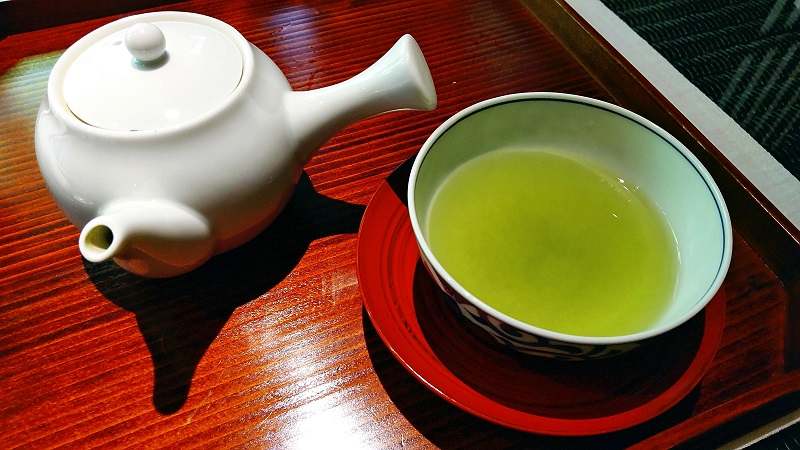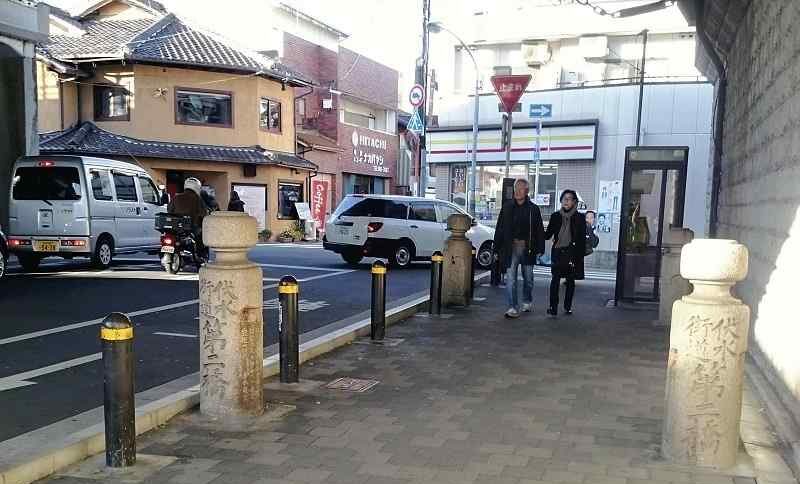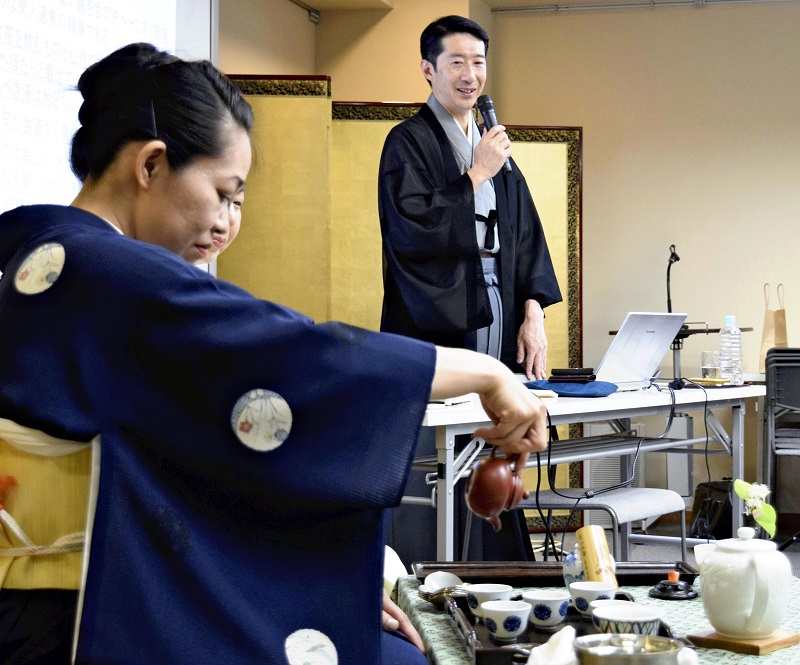Secrets of Kyoto / Sencha vs matcha: Same roots, different paths

Sencha green tea is seen in Marukyu Koyamaen’s Nishinotoin cafe in Nakagyo Ward, Kyoto.
14:16 JST, August 23, 2022
Matcha is an integral part of the Japanese tea ceremony. It is made from tea leaves that are powdered and dissolved in hot water. Eisai, a Zen monk of the Kamakura period (late 12th century to 1333), brought back from China both tea seeds and the method for drinking the tea. The practice, which incorporated Zen Buddhism as its spiritual bedrock, became the blueprint for the Japanese tea ceremony, called “chado” or “sado” (the way of tea). The ceremony features ritualistic ways to serve and drink tea and requires years of training to become an expert.
Unlike matcha, ryokucha (green tea) is widely drunk in Japan in everyday life. Ryokucha is made by steeping tea leaves in hot water to draw out their flavor and aroma. There are various types of green tea, the most common being sencha. In the early Edo period (1603-1867), a method of drinking sencha was introduced from China by Yinyuan (known as Ingen in Japan), a Chinese Zen monk who in Japan founded Obakushu, a Zen Buddhism sect, based primarily on Chinese culture.
Sencha-drinking developed into sencha-do (the way of sencha tea). I feel that sencha-do is less “domineering,” compared to matcha-drinking, likely due to the personality of Baisao (1675-1763), who spread awareness of sencha throughout society and hated authority. Baisao, meaning “elderly tea-peddler,” is a kind of nickname. His real name was Shibayama Gensho — an Obakushu monk who entered the priesthood at Ryushinji temple in Hizen Province (present-day Saga Prefecture) and was dubbed “Gekkai.”
Baisao visited and trained at Manpukuji temple, which was founded by Ingen in Uji, south of Kyoto. He then returned to Ryushinji and finally left the temple in his 50s. He probably was not a fan of the authoritative nature of Zen Buddhism. It is said that he later lived in Kyoto and was active as a begging priest in the Kansai region.
After reaching 60, he withdrew from the harsh life of seeking alms and opened a tea shop named Tsusen-tei in the Higashiyama area of Kyoto — the very first cafe in Japan. Carrying tea utensils on his back, he would occasionally set out to sell tea at various locations such as cherry blossom- and colored leaf-viewing spots in spring and autumn, respectively. It is said that wherever he went, he would put up a sign saying: “You can decide how much you pay for my tea. It could be anywhere from 2,000 ryo (about ¥100 million today) to half a mon (about ¥10). You can even drink it without paying. But I can’t make it any cheaper than free.”

Tsusen-tei, a tea shop operated by Baisao, is believed to have been located around Ninohashi along the Fushimi Kaido highway near Tofukuji temple in Higashiyama Ward, Kyoto.
Baisao’s way of life stood in stark contrast to that of Sen no Rikyu, who established the matcha tea-drinking style in the 16th century. Partly because he was a merchant in Sakai, Sen no Rikyu traded tea utensils at high prices under the patronage of supreme ruler Toyotomi Hideyoshi. In feudal Japan, peddlers were part of the lower social class. It is extraordinary that an elite cultural figure like Baisao entered the business — not least because Buddhist precepts forbade Buddhist monks from selling goods for a living.
As a talented writer of Chinese poetry and a highly regarded calligrapher, Baisao attracted cultural figures from across Kyoto. It was said that drinking tea with Baisao was a testament to being a first-rate person. Thanks to these visits, details began to spread on how to use teapots and other sencha utensils, and how to “properly” drink tea.
Noted artist Ito Jakuchu painted a portrait of Baisao, whom he considered a close friend. The painting depicts Baisao as a thin old man with a broad forehead and slightly curly gray hair.
Sencha-do became very popular in the 19th century around the end of the Edo period and the time of the Meiji Restoration. Various documents record that the tea was favored by literati and court nobles, as well as samurai warriors who revered the emperor and sought the expulsion of foreign powers.
Since then, sencha tea has become part of Japanese daily life. Many people drink it without fretting about utensils and drinking style. Many young people eschew teapots and instead buy plastic bottles of the tea. Nevertheless, ritualized matcha tea-drinking survives, thanks to the established distinction between drinking sencha on a casual basis and drinking matcha on special occasions.

Ogawa Koraku, standing, the head of the Ogawa-ryu style of sencha, explains the process of serving sencha, in Kamigyo Ward, Kyoto.
"JN Specialities" POPULAR ARTICLE
JN ACCESS RANKING






